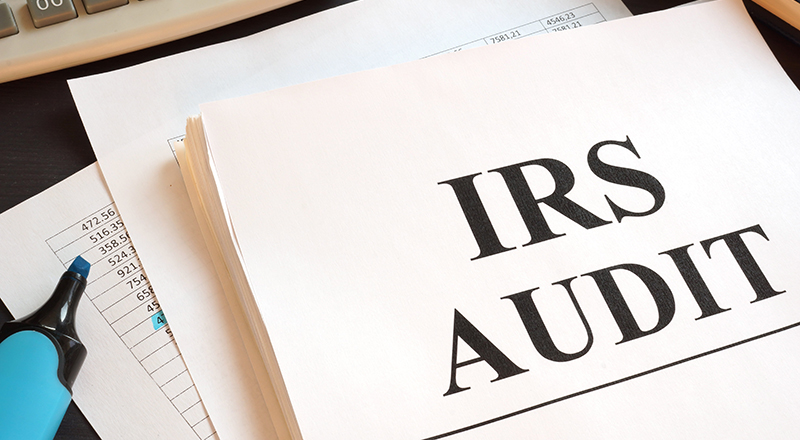How long does the IRS audit process take?
October, 15 2020 by Carolyn Richardson, EA, MBA
I’ve handled hundreds of audits over the years, and the question that comes up most frequently (after “Why me?”) is “How long is this going to take?” How long it takes for an audit to be finished can vary wildly. The length of time for the wheels of the audit process to grind through depends heavily on what kind of issues are being addressed, the level of documentation required, and which part of the Examination Division is doing the audit. More complex audits, such as those involving flow-through income from businesses such as sole proprietorships, partnerships, LLCs, or S corporations, are likely to take longer to complete. On the other hand, if the only item being questioned is the taxpayer’s charitable contributions, the audit is likely to conclude fairly quickly, even if it seems like an eternity to the taxpayer.
Since the audit process can vary dramatically, let’s talk about what kinds of audits the IRS performs and how long they normally last. Keep in mind that many of these numbers are averages based on experience and that an audit may take less time or more time depending on the taxpayer’s particular situation. Additionally, due to the Covid-19 pandemic and the large backup of correspondence at the IRS service centers, audits are taking longer.
Correspondence Audits
Correspondence audits are conducted from the service centers and normally are simple audits. That doesn’t mean they are the fastest audits, however. They are generally limited to one or a few items on the tax return. They also tend to be less complicated because they are usually limited to itemized deductions or other straightforward deductions on the tax return, such as retirement plan rollovers or contributions, or rental property deductions. However, because these correspondence audits are handled through the mail, they can take a little longer than you would think. For example, the initial contact letter to the taxpayer gives the taxpayer 30 days to submit documentation. Those 30 days can be extended by another 30 days if the taxpayer needs additional time to put their documentation together and submit it. Once the documents are mailed to the IRS, it becomes difficult to track who has the case. Correspondence audits are not assigned to a particular tax auditor, and because of that, the taxpayer’s response may sit for anywhere from 30 days to possibly 90 or 120 days before one of the examiners at the service center actually looks at it. Taxpayers who attempt to follow up with the IRS during this waiting period will find themselves engaging in a game of “whack-a-mole” in attempting to find out the status of their case.
If the taxpayer’s first documentation submission is adequate to support the deduction, the tax auditor will issue a “no change” letter, and the case will be closed approximately 30 days later. If the examiner feels the taxpayer did not support the deduction, they will issue an examination report to inform the taxpayer of the potential tax owed on the audit adjustments, or more infrequently, they may request additional information from the taxpayer. Generally, correspondence audits result in either a no-change letter or an audit report and not a request for more documents. The audit report will usually explain why the IRS auditor felt the documents did not support the taxpayer’s position. This is important information. If an audit report is received, the taxpayer normally has between 15 and 30 days to respond back to the IRS by either agreeing with the changes or by submitting additional documentation to support their position on the tax return, based on the inadequacies explained in the audit report. If the taxpayer needs to send in additional documentation, the process starts all over again with the new response sitting at the service center until another examiner looks at the case file and reviews the new documents. As a result, you can expect a correspondence audit to take, at a minimum, approximately five to six months to finish and, more likely, even longer than that. This is especially true after the IRS was required to shutter its service centers because of the Covid-19 pandemic, resulting in a large backlog of correspondence at the IRS facilities. Consequently, taxpayer responses to correspondence audits sat for an additional two to three months over the usual time periods.
Office Examination
The second most common audit is what we refer to as an office examination. Office examinations are handled by the IRS’s Tax Compliance Officers (TCO). This is what most taxpayers think of as an examination. In this type of audit, the IRS sends the letter to the taxpayer requesting that they appear at the IRS office at a certain date and time, with their documents in hand. This letter is normally accompanied by an information document request outlining the items under examination and identifying documents the taxpayer should bring with them to the appointment. While taxpayers can request additional time to put their documents together, in general the examiners will only allow one postponement of the initial appointment. The advantage (if there is one) of these audits over correspondence audits is that while these examinations do tend to involve more issues (such as the entire Schedule A), they might also be of issues similar to the correspondence audits.
Additionally, the case is assigned to a particular IRS examiner so the taxpayer has an actual name and number attached to the case. Taxpayers can call the examiner to follow up if delays happen or if they need additional time to secure documentation. Also, these examiners are generally local to the taxpayer, and the IRS office is generally within a reasonable driving distance.
In the age of COVID-19, the IRS is still performing face-to-face office examinations with safety precautions in mind, but they are expanding their correspondence audits as well. Tax examiners who handle face-to-face audits may also decide to handle an examination with the taxpayer via correspondence, particularly if the taxpayer has moved out of the local area, rather than reassigning the case to another IRS office (reassigning the case can add several months to the timeline). Tax examiners who handled the office examinations tend to try to complete the audit in one appointment, so these are actually the fastest audits to complete. They can be completed the day of the audit appointment, so they are concluded in about 30 days from the date of the initial letter received by the taxpayer. However, sometimes additional follow up appointments are necessary. If you need more time to secure documentation, the examiner may grant an extension and set another appointment approximately three weeks later than the initial appointment, although this can be at their discretion. Taxpayers are expected to provide all the documents requested at the initial appointment. If the documentation is not secured by the second appointment, they will issue an audit report.
Field Examination
The third most common level of examination is what the IRS refers to as a field examination. Field examinations are conducted by Revenue Agents. Revenue agents will generally go to the taxpayer’s home or business in order to conduct the examination rather than having the taxpayer come to the IRS office (so the audit is being conducted “in the field”). This is because field examinations are generally used for businesses such as corporations or partnerships, and high-income taxpayers who have their own businesses or complicated tax returns. Because these tend to be the most complicated returns of the individual audits, they are more time consuming. As a result, it may take a few months and multiple appointments to complete the audit. These audits can and do frequently go on for more than a year. Again, while the taxpayer has a contact name and phone number at the IRS of the person handling their examination, the disadvantage of these audits is the fact that they do take more time. And because they involve more complicated tax issues, the results of these audits tend to result in more taxes due back to the IRS from the taxpayer. Also, because revenue agents are not restricted to what audit issues they may examine, it is not uncommon for revenue agents to expand the examination beyond the issues originally identified at the start of the audit. They will also frequently expand the audit to additional tax years if problems are found to verify that the taxpayer did not follow a consistent pattern, so the taxpayer may owe taxes for more than one year (TCOs can also do this in office examinations but do it less frequently). If the revenue agent expands the examination to additional tax years, that will increase the amount of time it takes to complete the audit, and the taxpayer can expect the audit to go on for at least a year and possibly longer.
Of course, there are other types of examinations that the IRS performs, which are more specialized, such as employment tax audits, excise tax audits, or large businesses. These examinations will vary in the amount of time it takes to complete them, and in some cases, the audit can drag on for years and years, particularly in the examination of large corporations.
Factors that Add More Time
What happens if the taxpayer doesn’t agree with the IRS changes to their tax return? If that is the case, taxpayers almost always have the right to appeal the IRS’s initial audit determination to the IRS’s Appeals division. This will result in additional delays in closing the examination, adding at least six months to the process. Like so many other parts of the IRS, Appeals has a heavy workload, and they give priority to cases that are coming to them through the Tax Court system, which are known as docketed cases. These cases are given priority because the Tax Court has its own timelines, frequently set by law, which the IRS and taxpayer must meet in order to pursue the audit adjustments in Tax Court. That means your average taxpayer who is going to Appeals directly from the examination process, without going through the Tax Court, is given a lower priority in resolving their case. Even in Tax Court cases, it can be approximately six months from the time the Tax Court petition is filed to the time the taxpayer receives a letter from an appeals officer. The initial contact letter with appeals will determine how much longer it will be before the appeal is heard.
Appeals are generally held through telephone conference calls, and it is not unusual from the initial assignment to the telephone conference being a period of several months. After the telephone conference has taken place, the appeals officer can request additional documentation (more delays) but generally will avoid doing so. It can be several months before a decision is rendered on the appeal. If the taxpayer doesn’t agree with appeals, they can petition the Tax Court at that time. That means at that point that the taxpayer is at the mercy of the Tax Court timetable. While the Tax Court system tries to hear cases fairly rapidly, it is not unusual for there to be at least a one year delay between when the taxpayer files their petition and the time the case is heard by the judge in the Tax Court. However, it can, be a much longer period of time before the case is heard in court.
If your audit letter is keeping you up at night, or you simply don’t have the time to deal with multiple appointments at the IRS, keep in mind that, as a taxpayer, you have the right to have someone represent you. While this can be a friend or relative, it is best to secure a competent representative who has many years in audit defense. And that’s where membership with TaxAudit can prove to be the best purchase you ever make.





